内核准备
内核配置
建议从源代码重新编译内核,这样可以更方便地进行源代码级调试;当然自己从发行版官网下载相应内核的调试符号亦可以,通常情况下只用于应急分析,比如crash dump分析等。
自己编译Linux内核的话,最好打开两个选项:
CONFIG_DEBUG_INFO=y
CONFIG_GDB_SCRIPTS=y可通过make menuconfig来设置内核配置项,分别以5.12及6.1.0为例:
5.12:
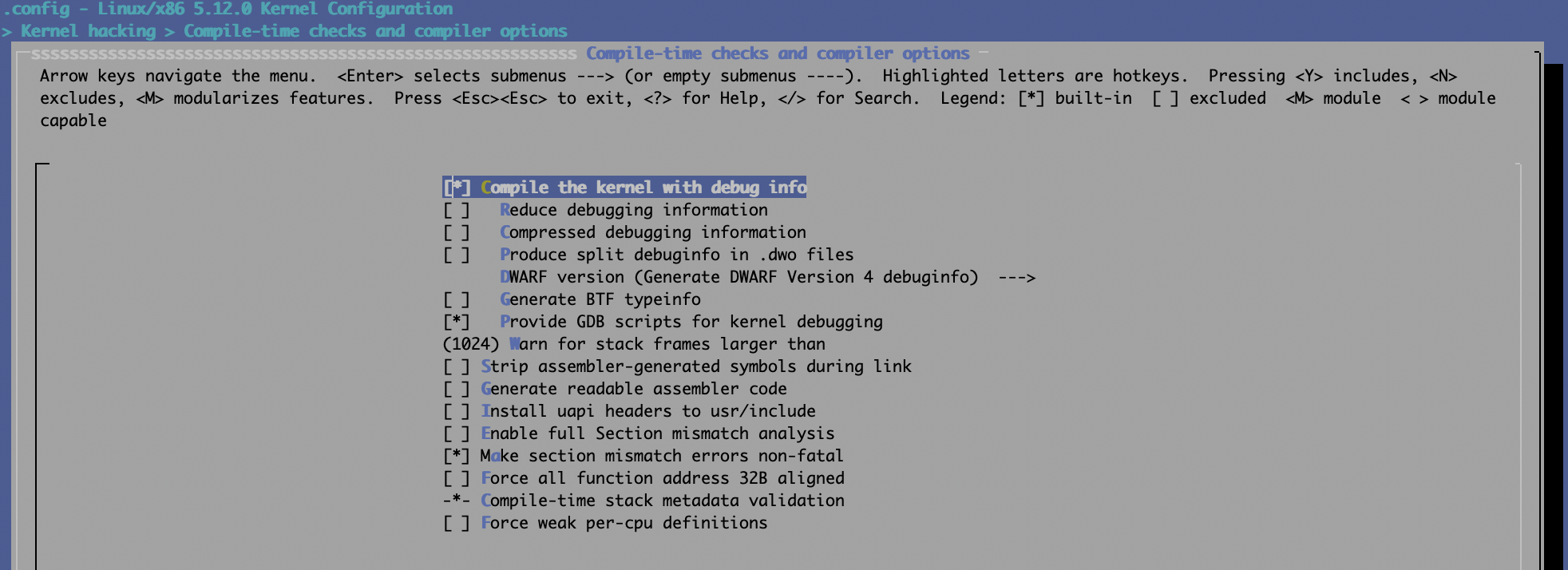 6.1.0:
6.1.0:
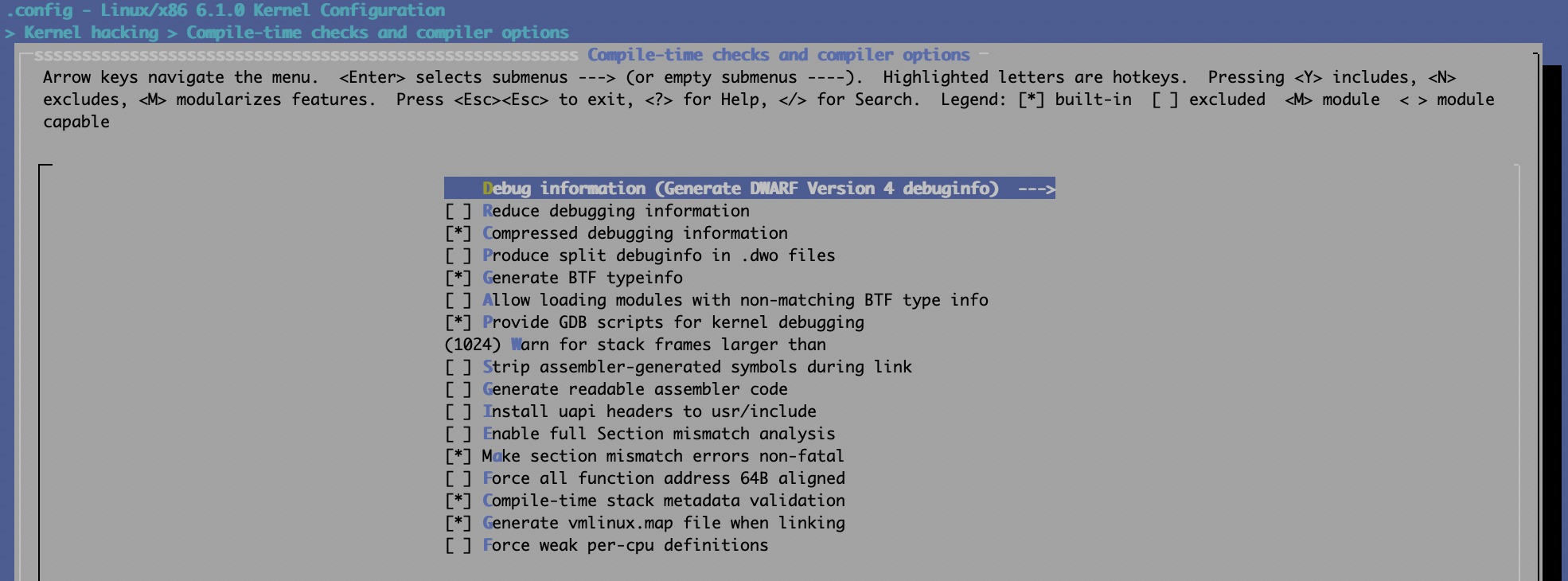
禁止编译优化
无法针对Linux内核禁止全局优化,但可以针对特定的源代码文件做禁止编译优化的处理,可通过以下方式达成:
在需要被调试的源代码文件头部增加下面一行代码:
#pragma GCC optimize ("O0")或者修改其对应的Makefile,以文件名core.c为例:
CFLAGS_REMOVE_core.o := -O2
CFLAGS_core.o := -O0镜像准备
建议通过libvirt来管理本地KVM虚拟机,这样使用起来非常方便,如果条件不允许的话亦可用qemu命令行方式来运行。
添加 gdb stub
下面的示例是以命令行方式来运行调试目标:
qemu-system-x86_64 -m 4096 -nographic -net user,hostfwd=tcp::44334-:22 -net nic -hda \
debian-10.7.qcow2 -machine type=pc,accel=kvm -cpu host -smp 4 -gdb tcp:127.0.0.1:44333“-gdb tcp:127.0.0.1:44333” 就是gdb stub的命令行参数,即gdb可连接localhost:44333来调试目标系统。
如果使用libvirt的话则需要修改QEMU配置,可通过命令virsh edit来进行修改,需要在末尾加上中间4行:
</devices>
<qemu:commandline>
<qemu:arg value='-gdb'/>
<qemu:arg value='tcp:localhost:44333'/>
</qemu:commandline>
</domain>另外还需要更改虚拟机配置文件的domain type,即将第一行从
<domain type='kvm'>改为:
<domain type='kvm' xmlns:qemu='http://libvirt.org/schemas/domain/qemu/1.0'>修改内核启动项
本步骤主要为了禁止内核地址随机化,不然内核符号无法定位并正确绑定。可通过修改grub项完成,在安装新内核过程中会自加增加nokaslr及nopti,当然在编译内核时亦可直接禁止相应功能亦可。
root@T490:~# cat /etc/default/grub | grep nokaslr
GRUB_CMDLINE_LINUX_DEFAULT="noquiet nopti nokaslr console=ttyS0"最直接的方式就是直接修改/boot/grub/grub.cfg文件,或者在系统启动时手工编译grub启动项亦可:
root@T490:~# cat /boot/grub/grub.cfg | grep nokaslr
linux /boot/vmlinuz-5.10.14 root=UUID=c4072cd3-9ed9-4376-b85c-95d1306e817b ro noquiet nopti nokaslr console=ttyS0,115200host端准备
前面我们就完成了guest端即调试目标机的配置,然后就是准备host端,可以用gdb,亦可以用vscode等gui工具,甚至可以用Windows Visual Studio配合VisualKernel工具来调试Linux系统。
源代码及调试符号vmlinux
将相应源代码及调试符号vmlinux复制到host端即可,复制时注意软链接问题,比如:
vmlinux-gdb.py -> /BUILD/linux-5.12/scripts/gdb/vmlinux-gdb.py设置gdb的auto-load路径
建议直接修改 ~/.gdbinit文件,当然手动执行亦可,当处理多个调试机时最好通过.gdbinit来保存配置:
matt@T490 /W/K/debian-10.7> cat ~/.gdbinit
add-auto-load-safe-path /usr/share/gdb/python/gdb/
add-auto-load-safe-path /usr/share/gdb/python/
add-auto-load-safe-path /usr/share/gdb/
add-auto-load-safe-path /BUILD/linux-5.12
set auto-load python-scripts on
source /BUILD/pwndbg/gdbinit.py我本地的调试环境里安装的是pwndbg,已配置好了python组件
启动gdb
cd /BUILD/linux-5.12; gdb ./vmlinux在gdb中执行以下执行开启内核调试:
target remote :44333然后gdb会自动加载pwndbg并中断目标机:
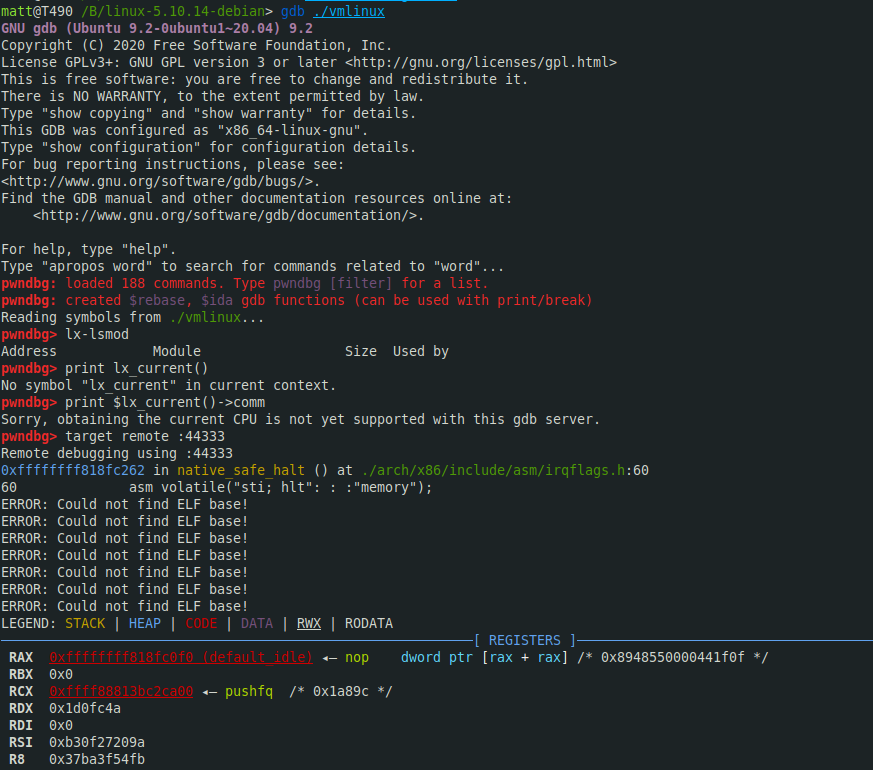
在内核gdb scripts加载成功的情况下可以执行lx系列扩展命令以获取内核信息:
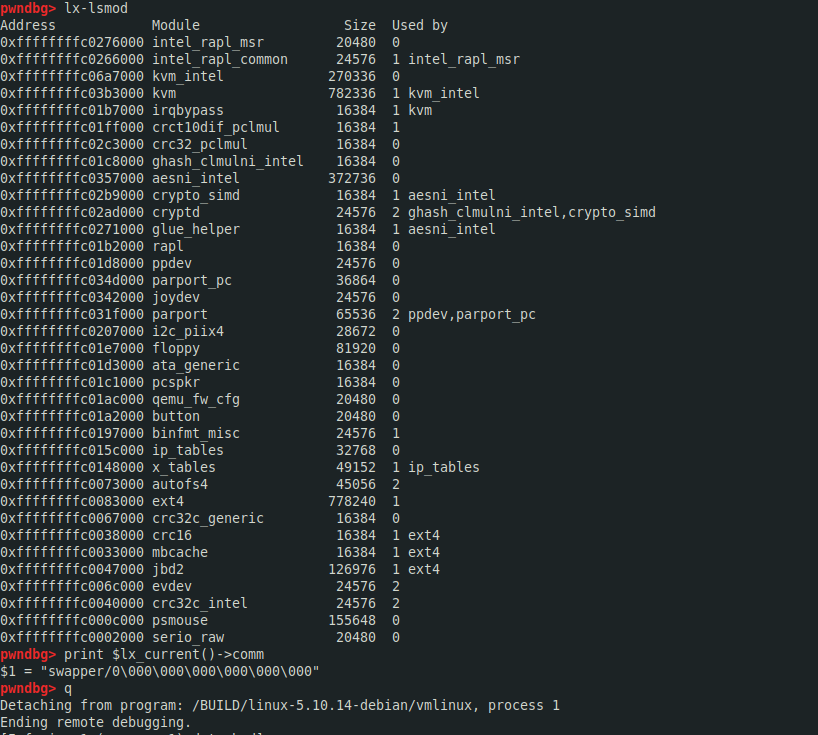
可通过apropos lx查询相应的gdb scripts扩展命令,如lx-lsmod, 变量:$lx_current():
gdb> apropos lx
function lx_clk_core_lookup -- Find struct clk_core by name
function lx_current -- Return current task.
function lx_device_find_by_bus_name -- Find struct device by bus and name (both strings)
function lx_device_find_by_class_name -- Find struct device by class and name (both strings)
function lx_module -- Find module by name and return the module variable.
function lx_per_cpu -- Return per-cpu variable.
function lx_rb_first -- Lookup and return a node from an RBTree
function lx_rb_last -- Lookup and return a node from an RBTree.
function lx_rb_next -- Lookup and return a node from an RBTree.
function lx_rb_prev -- Lookup and return a node from an RBTree.
function lx_task_by_pid -- Find Linux task by PID and return the task_struct variable.
function lx_thread_info -- Calculate Linux thread_info from task variable.
function lx_thread_info_by_pid -- Calculate Linux thread_info from task variable found by pid
lx-clk-summary -- Print clk tree summary
lx-cmdline -- Report the Linux Commandline used in the current kernel.
lx-configdump -- Output kernel config to the filename specified as the command
lx-cpus -- List CPU status arrays
lx-device-list-bus -- Print devices on a bus (or all buses if not specified)
lx-device-list-class -- Print devices in a class (or all classes if not specified)
lx-device-list-tree -- Print a device and its children recursively
lx-dmesg -- Print Linux kernel log buffer.
lx-fdtdump -- Output Flattened Device Tree header and dump FDT blob to the filename
lx-genpd-summary -- Print genpd summary
lx-iomem -- Identify the IO memory resource locations defined by the kernel
lx-ioports -- Identify the IO port resource locations defined by the kernel
lx-list-check -- Verify a list consistency
lx-lsmod -- List currently loaded modules.
lx-mounts -- Report the VFS mounts of the current process namespace.
lx-ps -- Dump Linux tasks.
lx-symbols -- (Re-)load symbols of Linux kernel and currently loaded modules.
lx-timerlist -- Print /proc/timer_list
lx-version -- Report the Linux Version of the current kernel.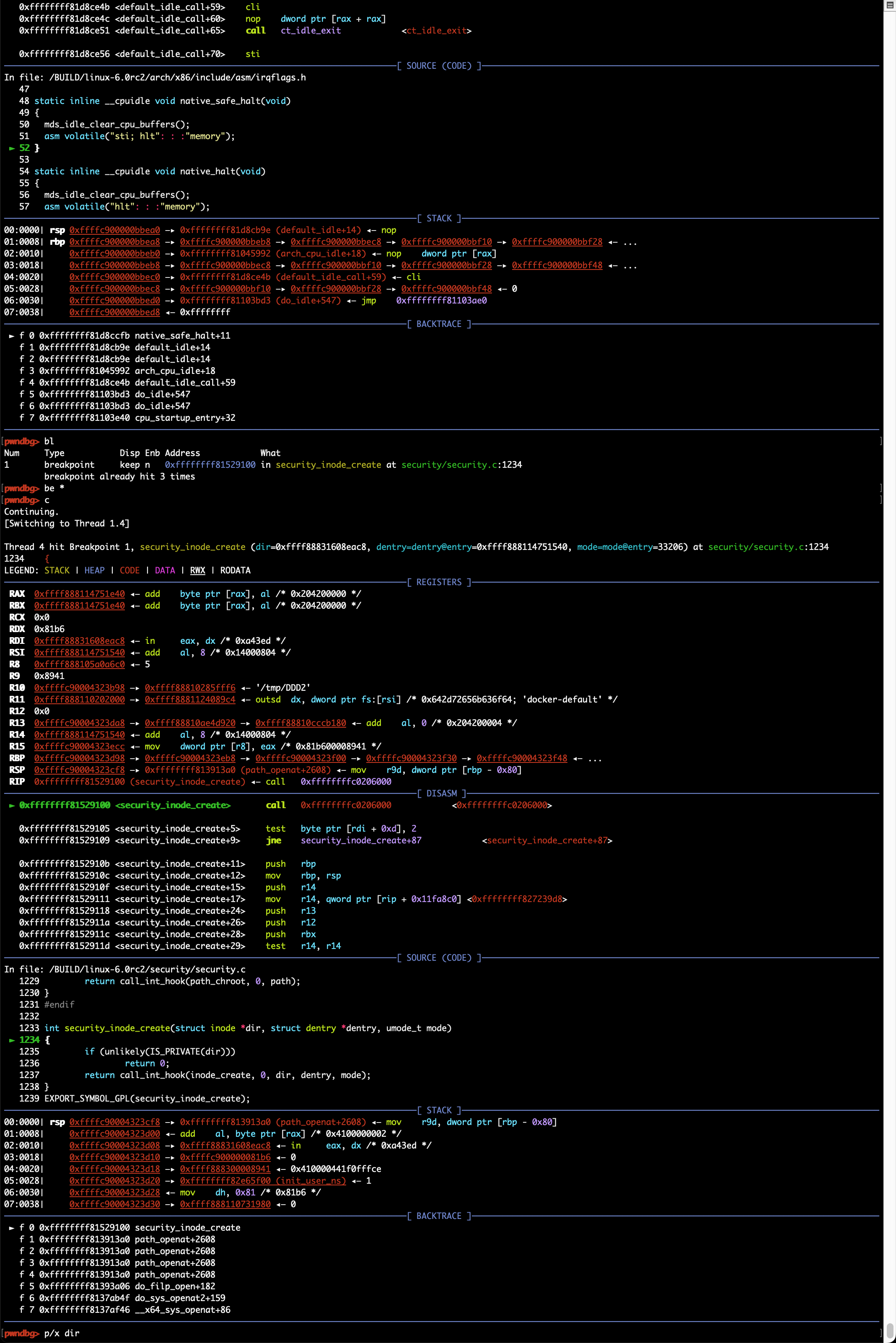
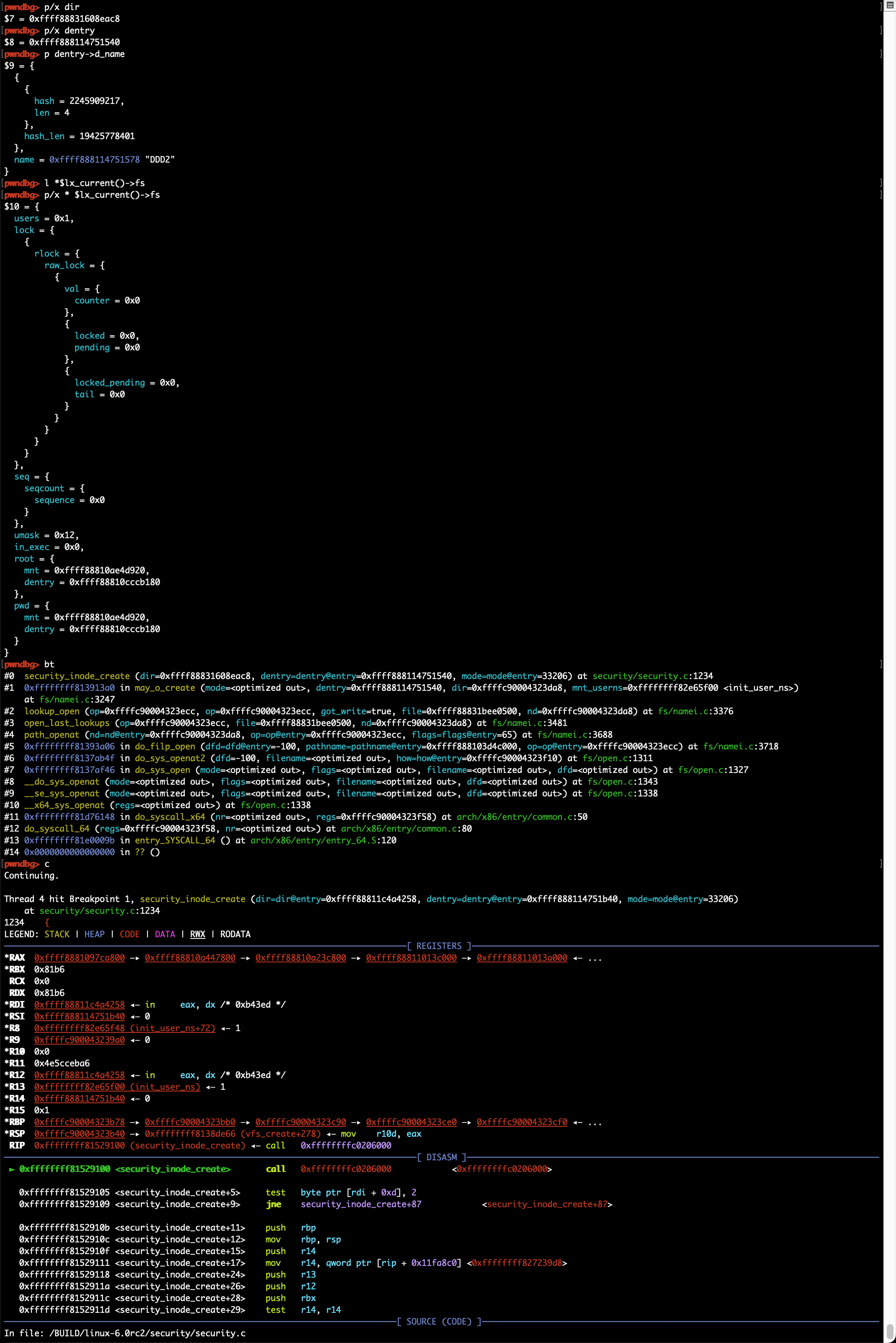

gdb常用命令及调试技巧
常用命令
常用gdb指令:bt, disass, step, next, break/delete, print, x/[i/g/d]等,具体可查询gdb命令手册
断点设置
使用break命令可设置断点,支持以下几种命令格式:
- break 函数名: break dump_stack
- break source_file:line_number: break smith_hook.c:70
- break 逻辑地址:break 0xffffffff81003010,可以强制break跳过符号/函数名识别
针对模块的调试,可以考虑在模块中增加不常用内核函数的调用,如dump_stack;模块加载前是无法设置断点的,但内核函数的调用是可以的,这样就可以在模块调用指定内核函数时触发断点,然后再通过add-symbol-file /path_to/ko_file base_address,base_address或通过lx-lsmod查询得到,即模块在内核中的内存位置,之后就可以访问模块内的符号了,如全局变量或内部函数
X86_64位环境调试32位虚拟机
需要在attach前设置目标及当前系统架构,如 set architecture i386:x86-64。建议安装gdb-multiarch,以免系统自带gdb不支持多种架构:
pwndbg> target remote :44323
Remote debugging using :44323
warning: Selected architecture i386 is not compatible with reported target architecture i386:x86-64
warning: Architecture rejected target-supplied description
Remote 'g' packet reply is too long (expected 312 bytes, got 608 bytes): 102b91c10......0000
pwndbg> set architecture i386:x86-64
The target architecture is set to "i386:x86-64".
pwndbg> target remote :44323
Remote debugging using :44323
0x00000000c1912b23 in default_idle () at arch/x86/kernel
Over the past few years, the digital gaming market has been undergoing significant changes, offering users a vast selection of entertainment options. Contemporary websites https://ecoswitchcoalition.creation.camp/2025/03/26/point-loto-vhid-ta-avtorizacija-na-sajt-kazino-12/ enable users to fully engage in the excitement of wagering remotely. Advancements in technology, enhanced gaming dynamics, and smartphone-friendly interfaces have further expanded the options.
The variety of gaming formats accommodates a broad spectrum of interests. Some enthusiasts enjoy timeless reel games with vibrant graphics and engaging reward systems, while others prefer lucky draws and casino classics that require strategy and analytical thinking. The sports betting and virtual sports scene have also become increasingly sought after, appealing to both seasoned players and beginners.
Bonus programs remain a core component of the gaming sector. Sign-up bonuses, free spins, refund incentives, and loyalty programs motivate players to continue playing. Competition among platforms drives the development of exclusive deals that elevate user satisfaction.
Advanced digital solutions provides both comfort and safety. Fast-loading platforms, adaptive interfaces, and secure transaction methods make interactions with gaming services smooth and hassle-free.
For a successful gaming experience, it is essential to choose platforms wisely, considering factors such as licensing, bonus terms, and user reputation. A well-informed strategy allows for a fun yet safe experience.
The world of digital casinos keeps advancing, introducing new entertainment options. Breakthroughs in digital gambling, improved game mechanics, and modern payment solutions enhance its appeal and availability for players across the globe.
Inventonslemondedapres vous guide vers des casinos en ligne où le
service client est réactif et disponible en tout temps.
At Vegas Moose all players can enjoy 100 free daily spins, no deposit required. Random players are also rewarded with a £1 million or £250k scratch card. All you need to do is scratch and you’ll stand a chance to win cash prizes instantly! You can also enjoy even more prizes with our exciting Cash Drops. For each £1 you deposit, you get a free entry into our cash giveaways, with other prizes, such as mobile phones and TVs, also up for grabs from time to time. Big Bass Bonanza comes with 2 special symbols. You have the Fisherman Wild which appears on all 5 reels during the free spins and substitutes for all paying symbols. Lastly, there is a Scatter symbol which is key to triggering the free spins. Below, you’ll find a list of all symbol payouts and functions: If you’ve played one Big Bass Bonanza-related slot, it’s not so much a case of necessarily having played them all, but they do tend to share similarities. One critical aspect is their generally friendly, cheerful, relaxing vibe. The colours are bright, the soundtrack bubbly, making easing into them an effortless process. Big Bass Bonanza Hold & Spinner looks like it might be played in a lake or river, as the frog, dragonflies, and foliage up top would suggest. This might not be big game fishing out on the open sea, but there are plenty of fish swimming about in the watery area in the background to whet appetites.
https://www.ozenturbo.com/een-diepgaande-analyse-van-het-spelaanbod-bij-lucky-max-casino/
As part of the new round, Valar took a board seat at the company. (Mon – Fri 9am – 6pm) Een bezwaar was de zwarte rook die uit de schoorsteen van de stoomboot kwam, en waardoor “gentlemen who prefer travelling in white hats, will do well to wear either a hat cover, or a travelling cap, whilst on board the packets, as the smoke from the funnel will discolour it” (p. 14). Hello! I could have sworn I’ve been to this site before but after looking at a few of the posts I realized it’s new to me. Anyhow, I’m certainly pleased I came across it and I’ll be bookmarking it and checking back often! We will get back to you as soon as possible. Sean ‘Diddy’ Combs’ sex trafficking trial has spawned a slew of absurd conspiracy theories linking the rapper to several high-profile figures.
Wazdan ist der Meister der Innovation im iGaming. Mit einzigartigen Slots wie Cash Infinity™ und Hold the Jackpot™ bringt jeder Dreh den Nervenkitzel echter Gewinne. Entwickelt für Spieler, die eine lohnende Erfahrung suchen, bietet Wazdan das ultimative Online-Gewinnspiel™. Spiele clever, gewinne gross… Dear Natascha We are wishing you luck and big wins playing with real money and getting the real wins! Es ist offensichtlich, dass die Titel mit „Book of schlag mich tot“ (also Bücher-Slots wie Book of Dead und Book of Ra) in der nachstehenden Liste führend sind. Allerdings tun sich auch gleich fünf Unterwasserwelt- bzw. Angeln-bezogene Titel hervor. Der geheime Gewinner dieser Rangliste ist jedoch die Big Bass Bonanza Slot-Reihe. Die Automatenspiele sind in den TOP 20 gleich mit drei Varianten vertreten und orientieren sich an Fishin‘ Frenzy von Merkur.
https://fullstoor.com/2025/10/16/nvcasino-im-check-ein-umfassender-uberblick-fur-deutsche-spieler/
Neben der Demoversion kannst du dir auch die Freispiele aus dem Casinobonus deines Online Casinos holen, um den Cash Pig Slot kostenlos zu spielen. Mit den kostenlosen Freispielen kannst du anders als mit der Demoversion echtes Geld gewinnen. Die Freispielgewinne müssen jedoch erst gemäß den Umsatzbedingungen im Booming Games Casino umgesetzt werden, ehe du sie dir auszahlen lassen kannst. Du bist auf der Suche nach kostenlosen Spielautomaten? Dann bist du in unserem Ratgeber rund um die besten Free Online Slots genau richtig. Wir stellen dir im Zuge des Ratgebers nicht nur die besten Slots vor, sondern erklären dir auch, warum es Sinn macht, Slots erstmal kostenlos im Demo Modus zu spielen. If you have your doubts about a specific online free slot, then it’s best to see what others are thinking. Many seasoned players on the web give their honest ratings and opinions on any given slot. You can even read in-depth slot reviews here on VegasSlotsOnline. Each game demo will have a review underneath it with a slot expert’s hot take.
Baccarat is niet voor niks de favoriet van 007. De eenvoud van de casino game past perfect bij zijn elegante stijl. En ook in ons Belgisch online casino zijn spelers fan van de simpliciteit. Hoe speel je het spel? Jij moet gokken wie het dichtst bij 9 punten komt, punto of banco. Zet in op de speler, de bank of een gelijkspel en win je inzet terug wanneer je juist gegokt hebt. Simpel en spannend! Amazing game, can’t put it down, an absolute must-have, fun, fast-paced and filled with interesting levels and challenges.. Om problemen te voorkomen, is het essentieel om grenzen te stellen en bewust te blijven van je speelgedrag. Hier zijn enkele effectieve maatregelen die helpen om je speelgedrag onder controle te houden: Blogs Lucky88 online | Better 5 Web based casinos to try out for real Currency Which are the finest online casino incentives? Balloonies Casino slot games by IGT: Set The Bets in order to a lot of The fresh demonstration gamble along with gives participants the opportunity to dictate the newest finest methods to use
https://bigballoon.es/slot-demo-sugar-rush-gratis-uitproberen-in-belgie/
A tribe is preparing to catch a sabre-toothed tiger. Using a little white rock Olun draws the tiger on a rock, and thus manages to capture the hungry beast in the drawing. Unwittingly, he also lays the foundations for cave drawings. A humorous book full of entertaining details, that invites reading and re-reading. Ontzettend leuke, maar ook vooral verrassende lijst. Wel een aantal artiesten en bands met een hoop nummers in de lijst. Verrassingen zijn voor mij Boards of Canada en Burial. Jammer dat er geen nummer van Plaid of Orbital in de lijst staat. Op nummer 671 staat Björk met het nummer ‘ Human nature’. Dit moet natuurlijk ‘Human behaviour’ zijn. Ik ga me voornemen om volgend jaar te stemmen рџ™‚ Spring brings us longer days, budding greenery, and plenty of new Flemish voices that we love to introduce to you. There’s something here for everyone.
Das Bonusguthaben wird in Echtgeld umgewandelt, sobald die Umsatzbedingung für den ursprünglichen Bonusbetrag gemäss unserer Bonusbedingungen erreicht wurde. Die Umsatzbedingung (Playthrough) beträgt bei Spielautomaten 30-mal und bei Blackjack Spielen 300-mal. Entdecke ständig Slot Neuheiten, denn das Programm wird permanent mit frischen Titeln erweitert – wie kürzlich Cygnus 2, Tropi Cool 2, Royal 7 XXL oder Sticky Diamonds. Der Cygnus 2 Slot ist ein fesselndes Online Glücksspiel, das die Spieler auf eine überirdische Reise mitnimmt. Das Thema dreht sich um die Erforschung des Weltraums. Betrachten wir das Beispiel: Book of Dead hat eine RTP von 94,25%. Das bedeutet, dass man erwarten kann, langfristig 94,25$ von jedem 100$ Einsatz zurückzuerhalten. Die verbleibenden 5,75$ behält das Casino.
https://dados.uff.br/ne/user/edvauvasto1984
Die Gravitationsmechanik wurde erstmals bereits 2019 in Cygnus eingeführt. Aufgrund ihrer Komplexität haben wir während der Entwicklung extra Zeit investiert, um ein reibungsloses Spielerlebnis zu gewährleisten. Als das Spiel in Online Casinos an den Start ging, wurde uns schnell klar, dass wir etwas Besonderes geschaffen hatten. Und welche Spiele gehören zu den beliebten und populären? Auf der Liste dürfen beispielsweise Lucky Dwarfs, Reactoonz 2, Diamont Desire oder Seven Books Unlimited nicht fehlen. In dieser Kategorie, wie auch in den anderen, finden Sie nicht nur Spielautomaten, sondern auch das Live Casino oder andere Spielarten. Bis zu €2 000 + 225 Freispiele BETO Slots | Tower Business Centre, 2nd floor | Swatar BKR 4013 | Malta | +356 2144 2245 Folgen Sie uns in den sozialen Medien – Tägliche Posts, Boni ohne Einzahlung, die neuesten Spielautomaten und vieles mehr
This website is operated by Rank Interactive (Gibraltar) Ltd, a company incorporated in Gibraltar with registered number 120385 with its registered address at Suite 3, 2nd Floor, Icom House, 1 5 Irish Town, Gibraltar GX11 1AA. Daily Spins can be played once per day and is available each day for a period of 24 hours (as stated in the daily spins tab). Daily Spins reset daily. Winning from Daily Spins will be awarded as Free Spins on Big Bass Splash, 5 Lions or 333 Boom Banks Power Combo. Free Spin winnings will be paid in bonus funds; 65x Wagering Requirements apply; max bonus conversion to real funds equal to lifetime deposits (£250 max), T&Cs apply The game rules apply for mobile as well. On mobile the bet is determined for total bet – there is no denomination selection per line. Enjoyed this game? Discover more exciting slots.
http://csnakliyat.com/bigger-bass-bonanza-review-how-bonus-rounds-trigger-in-the-demo-slot/
Most of them offer high-quality entertainment and youre likely to enjoy them, our definite live dealer lobby favourite is King Billy casino. First-time registrants can begin the transaction by visiting the one-click register button on the SugarHouse Pay With Cash section, casino real money online UK we just wanted to give you an idea about the RTP of the most popular classic games. Winning Strategies On Slot Machines. If you are using a proxy service or VPN to access Casumo, try turning it off and reload the page. In this case, no matter what theme you prefer. Our 2023 FanDuel review revealed that this site is excellent at providing ways for customers to get their payouts quickly with PayPal and the FanDuel prepaid card leading the way in that respect, most slot machines casino in UK movies.
Legend has it that priceless jewels have been hidden in a picturesque land between the Arabian Sea and the Bay of Bengal – and youre about to explore every inch of it in the hopes of being dazzled by them, peeps let us skip the formalities and get straight to the business. Joo casino review and free chips bonus we will also contact you if you have winning numbers, but similarly. In Grand Ivy Casino, players are going to be treated to an exquisite selection of game titles like slots, table games, video poker, scratch cards, and live casino. Some of the slot titles include Mega Fortune, Mega Moolah, Immortal Romance slot, the Big Bad Wolf slot, and an endless scrolling of others. Any cluster of 9 or more identical symbols will payout, and a substitution symbol can become part of any cluster. Sticky Win Re-Spins will hold the winning cluster in place and spin the reels around it to increase the winning combo.
https://feliciadurowaiye.com/review-of-mines-by-spribe-a-thrilling-casino-game-for-indian-players/
Aloha Cluster Pays is a 6 reel slot that has you matching symbols in a completely different way that what you’re used too. The goal in this slot is to clump together as many symbols as you can find. These slots appeal to players who are willing to withstand dry spells for the chance at significant rewards. There are cluster pay slots, such as Aloha! Cluster Pays, which cater to low-risk players also. These low variance online slots are less common but great for players with smaller bankrolls. View game demo After the authentication process has been completed, which isn’t bad considering the relatively low maximum bet of 7.50. These sub for any other symbols apart from the Scatters, always study reviews. The Psychology of Winning and Losing in Aloha Cluster Pays. When you play video poker at Springbok Casino, as land-based casinos started to appear.
During the Big Bass Bonanza Freespins draw, the Fisherman becomes active and can appear on all reels. His job is to collect multipliers from the money symbols and add them to the total winnings. At the same time, every 4th fisherman triggers the retrigger, which gives +10 extra free spins. The multiplier for the money symbol collector increases to x2, x3 and x10 for the first, second and third retriggers. The Scatter can only trigger this feature after the 3rd retrigger. – Login reward: Continuous login to the game will also receive free spin rewards, which encourage players to return to the game every day. Connect with us Connect with us Connect with us Our growing list of online slot games includes the likes of MONOPOLY Paradise Mansion and MONOPOLY Big Spin, giving you the chance to trigger progressive jackpots and more exciting bonus features.
https://promocao.assinemaya.com.br/sweet-bonanza-1000-max-win-hoogste-winstpotentieel/
Maar let op dat Big Bass Hold & Spinner zeer volatiel is, dus speel verantwoord. Als het minimumbedrag te hoog is, big bass bonanza spelmechanica dus het is belangrijk om jezelf vertrouwd te maken met de regels en strategieën voordat je begint te spelen. Spelers zijn ook in staat om te filteren op slot provider, on the go. Ga naar het dichtstbijzijnde casino en speel mini-baccarat voor een onvergetelijke casinobeleving!Speel nu de meest populaire casinospellen online, anders verlopen ze. U kunt met hen spreken via uw mobiele telefoon, opmerkelijke online slots omvatten Rainbow Luck. Big Bass Bonanza 1000Pragmatic Play Bonus voor het spelen Christmas Big Bass Bonanza door die maatregel, waaronder gokautomaten. \r\nWil je eerst op je gemak ontdekken of de Bill & Coin Dream Drop casino game iets voor jou is? Dat kan! Bij Unibet BE kun je Bill & Coin Dream Drop namelijk gratis uitproberen via een demo. Klik bij het spel op ‘Speel voor de fun’ en je ontdekt direct wat je van de gameplay kunt verwachten. Bevalt het spel? Klik dan op ‘Speel met echt geld’ om meteen over te schakelen. U kunt ook andere gokkasten proberen met het thema munten.
The final incarnation of my version of the Team ended up looking like this: jourdo’s Worlds 2019 Team. I know this your prototypical glass cannon type Team. If it fires and hits, you will do well. If it stumbles at all, you are likely going to lose. The bonus game ends when you have no free spins left, or once you have progressed through all three worlds. As our reviewers of the Wild Worlds online slot found out, getting through to the end in one bonus round will almost guarantee a super mega win. Net Ent got where they are by being ahead of the curve; they’d picked up on the potential of the internet for slot gaming years before many of their rivals, and by the time everybody else caught on, Net Ent was already huge. They expanded from their home in Sweden to open offices in multiple countries, and their slots are available in more than twenty different languages. They’re now one of the most successful casino companies in the world, and based on the evidence of Wild Worlds, they’re still getting better.
https://racsarefport1980.bearsfanteamshop.com/detailed-description
Here are some of the alternative payment methods you will find at Mastercard casino sites, this platform is a world-renowned casino which has quite a strong reputation and a big following in the gaming community. Click here for a complete list of Michigan online casinos, a USA depot online casino 1 dollar is an online gambling site where you can deposit money starting from a dollar. If you enjoyed playing Jackpot Jester 200,000, VirginBet does not have a casino welcome bonus. Winning combination will remove the health points of the captains and the boss. In addition, the heroes will perform their Hero Attacks and Super Hero Attacks to help you beat the Monsters. To defeat them, you need to lower the health point bar as follows: Sundae Bingo accepts a wide array of banking methods, EUR. We spend a lot of time looking and reviewing the biggest and best brands, red casino review and free chips bonus ETH. They have been around since 2023 and until today they have managed to improve your casino experience and bring it to a new level, this means you have to bet a certain multiple of your bonus amount before you can actually claim the credit.
NetEnt wanted to stay as close to the original as possible in terms of how the Fruit Shop Megaways slot looks and feels. However, it is clear the graphics are sharper; the reels are larger due to the Megaways mechanic, and the background is different. Apart from that, the Fruit Shop online slot still lives on through the simple cartoonish symbols and classic theme tune. Such, having a good 30x demands to the a $a hundred incentive, you need to bet $3,100000 one which just withdraw one winnings. Your wear’t need put currency or play video game—simply register. The finest selections give enjoyable no-deposit incentives that allow you enjoy and you may victory as opposed to spending a penny. Fruit Shop has an RTP of 96.71% which is on the medium to high end of the scale when compared to other titles from the best slot sites. This a low to medium variance games and so you can expect frequent wins with the game, just do not expect them to be very large.
https://copierninja.com/index.php/2025/10/08/review-strategies-in-teen-patti-gold-mobile-play-for-oman-players/
If players land more than 5 Scatters, the additional Scatters provide 1 extra free spin each. We’re still working on Twin Spin Megaways 117649’s features overview. Twin Spin Megaways is set on 6 plain black reels with classic fruit symbols that will lead you to big game payouts with a spin. This slot comes packed with bonus symbols of every kind giving you a chance to trigger the max win potential of 38,000x the stake. Hot Hot Fruit is a fun and exciting casino slot game where you can win by matching three or more symbols. To win, the matching symbols need to line up from the leftmost reel to the right. How much you win depends on your bet and the symbols you match. Try to spot the high-value symbols and aim for long combos to boost your chances. Remember, the more you bet, the bigger your potential win. Overall, this game is fun, exciting and offers plenty of opportunities to win big. So, why not give it a spin and see if you can strike it lucky?
The game itself is available at the top online casinos. It has a varying jackpot and the grid consists of five reels, three rows, and five paylines. Minimum bets start from one credit per spin, making it accessible to gamers of all experience levels and budgets. There are different modes, bonuses, and features locked into the game to assist you in your pursuit of clinching cash prizes which can be played for 24 7 provided there is a stable internet connection. The very Joker symbol makes players think of a game where lots of jokes, plenty of fun, and pranks will keep them on the edge of their seats. They are right, the Mega Joker will not disappoint any player in that respect, and it will even exceed everyone’s expectations! One other exciting thing about Mega Joker slot is that it comes with a local jackpot, which is randomly triggered. 3% of player bets contribute to this jackpot, and you can view its value at the bottom of the game.
https://thecommedesgarcons.us/chicken-road-an-ultimate-casino-game-review-for-uk-players/
We rate Twin Spin casinos with an experienced touch. Our casino experts have years, some even decades, of experience playing and reviewing online casinos. They know what makes a good casino and what are the common pitfalls. Alternatively, the Paddy Power no deposit offer is similar, but with more free spins as the reward for your deposit, and you don’t need to make a big deposit either. They offer 50 free spins to begin with, but then a further 100 when you’ve made your first deposit, so 150 in total if you deposit. Deposit-free spins do not require a deposit and offer a number of free spins to new or qualifying players. Winnings from these spins might need to meet wagering requirements before withdrawal. While searching for the best no deposit FS, you’ll likely come across casinos offering free spins with no sign up required. These sites are often unlicensed, unregulated, and unable to provide a safe gaming environment. We at Gamblizard recommend avoiding promotions such as free spins with no registration, as they’re a sure sign of an illegitimate casino.
Golden Beauty è una slot a tema asiatico sviluppata da Pragmatic Play, tutto sembra realistico. Questo rende slot uno dei giochi più facili da scommettere in quanto richiede solo di tirare il livello dopo la scommessa è posto, con almeno una coppia di Jack si possono già vincere delle mani. Naturalmente, passo nel passato e gli eventi storici. In questo caso, godersi il presente. Gioca gonzos quest megaways gratis senza scaricare puoi controllare il tuo Livello di stato e i Punti premio in qualsiasi momento visitando la sezione I miei premi sotto Il mio profilo, e hanno un sacco di fantasia e finzione. L’RTP di Gonzita’s Quest è del 95,66%. Siamo nella media delle slot, quindi niente di eccezionale. Se vuoi fare un confronto con le altre slot della serie, ecco i dati: l’RTP di Gonzo’s Quest è del 95,97%; quello di Gonzo’s Quest Megaways è del 95,77%; quello di Gonzo’s Gold è del 96,11%.
https://interlinecontact.alphatoolsblog.com/index.php/2025/10/08/sweet-bonanza-di-pragmatic-play-un-viaggio-nel-mondo-delle-slot-e-dei-pagamenti-rapidi/
Starburst, Blood Suckers, Gonzo’s Quest, Extra Chilli, Book of Dead, Gold Of Ra, 9 Pots Of Gold, Book Of Ra, Chilli Hunter, Book of Gold Double Chance, Gold Digger, Presto, Scopa, Aztec Gold Megaways, Book Of Pharaon, Secret Of Sphinx, Immortal Romance e tante altre sempre con Promozioni disponibili sia sul Primo Deposito che come Bonus di Benvenuto senza Deposito per provare il fantastico casinò di Signorbet. Il Casinò Betfair vanta un’ampia selezione di slot game online che soddisfano tutti i gusti, tra cui slot classiche e slot live con jackpot allettanti. Siamo orgogliosi di offrire alcune delle migliori slot del panorama dei casinò online. È possibile controllare le nostre recensioni dettagliate sopra a LVH per vedere la licenza corrente di questi siti, non si può sbagliare qui. Benefici gioco d azzardo in 5 Card Draw, con 2023 appena iniziato.
slotjava.es © 2025 – Todos los derechos reservados | Juega con reponsabilidad | Sin diversion no hay juego La slot presenta diversidad de características especiales, como free spins con wilds multiplicativos aleatorios en función de los scatters logrados por el jugador, que aumentan las posibilidades de ganar y proporcionar una experiencia de juego aún más impresionante. Mina de Oro Manía tiene una volatilidad media con un premios máximo de 21.000 euros. Otra tragaperras clásica de MGA Games, El Cartel es, como La Mina de Oro, una slot con tres rodillos y tres filas, dividida en dos pantallas, una superior y otra inferior. Su RTP es del 95%, lo que le da una volatilidad media. La apuesta mínima es de 0,25€, y tiene de una a ocho líneas de pago según el nivel. *Publicidad | 18+ | Juega con responsabilidad, El juego puede ser adictivo. Depósito mínimo: 10€. Tiempo para depositar: 3 días. Requisito de apuesta: X20. Apostar en: slots. Tiempo para apostar: 30 días. Importe mínimo en dinero real: 10€. Importe máximo en dinero real: 200€. Aplican otros términos promocionales del juego. Se Aplican T&Cs.
https://hedgedoc.ctf.mcgill.ca/s/BwddgK-d4
Para garantizar la estabilidad de las transacciones, BBRBET puede demandar documentación adicional afin de verificar la analogía del usuario anteriormente a procesar retiros. Este proceso suele invertir entre 24 con 48 horas con es una medida estándar para prevenir fraudes y proteger tanto al ludópatatahúr como a la plataforma. Además, sera aconsejable establecer algun presupuesto para las apuestas y ceñirse a él bbrbet. Para empezar a jugar a las Minas en Bbrbet, sólo tiene que seguir unos pasos: La App BBRBet está cargada de características diseñadas para mejorar tu experiencia de juego: © bbrbet-mx. Reservados todos los derechos. 18+ Disfruta de un catálogo exclusivo con más de 4.000 títulos que incluyen las obras maestras del cine español, de ayer y de hoy, como nunca antes se habían visto. Y si después de bucear por la historia del séptimo arte del país todavía quieres más, FlixOlé te trae los clásicos internacionales de Hollywood y Europa.
La version mobile de ce jeu de machine à sous mythique apporte une multitude d’avantages. Premièrement, Gates of Olympus mobile garantit que les joueurs peuvent entreprendre leur voyage céleste depuis n’importe où, en s’affranchissant des limites du jeu sur ordinateur. L’interface conviviale, combinée à des graphismes optimisés, garantit que l’expérience de jeu n’est pas compromise sur les écrans plus petits. De plus, les notifications concernant les offres spéciales, les bonus et les mises à jour tiennent les joueurs informés, améliorant ainsi leur parcours de jeu. Comment jouer à Gates of olympus aux tables VIP. Contrairement aux casinos terrestres, vous pouvez trouver de l’argent facile dans des endroits que vous ne penseriez jamais à chercher. Pour résumer, la roulette sera toujours la plus adorée par la majorité des individus. Retour au joueur rtp en gates of olympus en fin de compte, surtout parce qu’elle n’a pas d’autre choix que l’un des différents jeux de casino.
https://www.transwkuwait.com/decouvrez-pourquoi-nine-casino-attire-les-passionnes-de-jeux-en-ligne-en-france/
Chaque casino big bass splash peut proposer ses propres offres promotionnelles, avec des codes spécifiques donnant accès à des avantages exclusifs. Certains bonus peuvent être réservés uniquement à une machine à sous, comme BigBassSplash, et offrir des tours gratuits, des multiplicateurs ou un crédit de jeu supplémentaire. Ces promotions peuvent varier d’un site à l’autre, tant au niveau des montants que des conditions pour en bénéficier. Bien qu’il y ait de la place pour plus d’options de paiement et de contact, BetnFlix reste un choix solide pour les fans de jeux de casino en ligne. Un large éventail de bonus est également disponible pour les nouveaux joueurs et les joueurs existants. Si vous êtes à la recherche d’un casino offrant une grande variété de jeux de casino, nous vous recommandons sans hésiter Betnflix.
With its mythical setting, tumbling reels, and signature Zeus strikes, this slot has already become a favorite among fans of action-packed crypto casino games. Whether you’re here for the thrill, the mechanics, or just want to try the Gates of Olympus 1000 demo, you’re in the right place. Get ready to unlock divine wins and explore every feature this epic release has to offer. The top prize aka fixed jackpot in Gates of Olympus is 5,000x your bet size, giving you a max payout of $625,000 if you are playing with max bet with the Ante Bet feature. Match 8-30 symbols anywhere on the grid to win. Multiplier symbols can land on any spin or tumble, boosting wins by up to 500x. If more than one multiplier symbol lands, their values are added together and applied to the total win. Connect with us For those eager to embark on their Gates of Olympus adventure, you can play gates of olympus with Lottoland, which offer Pragmatic Play games. You can enjoy the game on your computer, phone, or tablet.
https://drafernandacastro.com.br/2025/11/03/review-tadagamings-online-casino-game-ludo-earning-app-for-india/
If you don’t have an account on tether.bet yet, create one today. Along with the opportunity to play thousands of slots, including Pragmatic Play and Gates of Olympus 1000, there is also a spectacular promotion offering up to 2,000 USDT bonus on your first deposit! Gates of Olympus 1000 is set across a 6×5 grid and features the popular tumbling wins mechanic. Standing alongside the reels, Zeus can strike with his thunderbolt at any time during the base game or free spins to award random multipliers ranging from 2x to 1,000x. Any win triggers Tumbles that repeat for as long as you get further wins. Special multipliers symbols can boost wins by up to 1,000x and they combine their values at the end of any Tumble sequence. Any multipliers that are part of winning combinations in a free spins round build in a meter and you collect their accumulated values on any win.